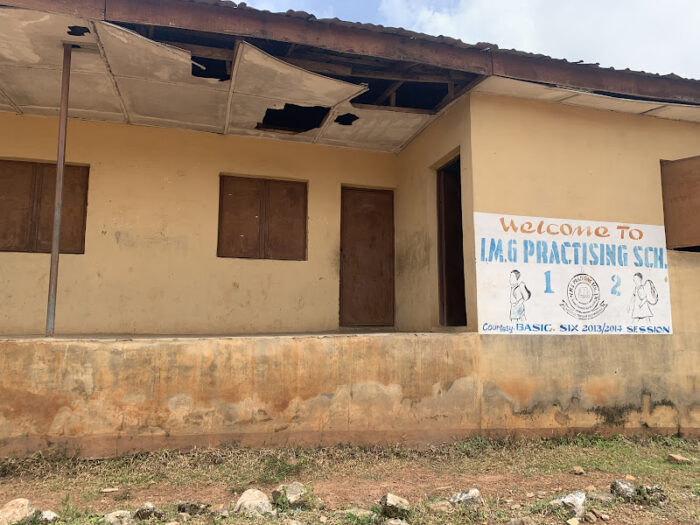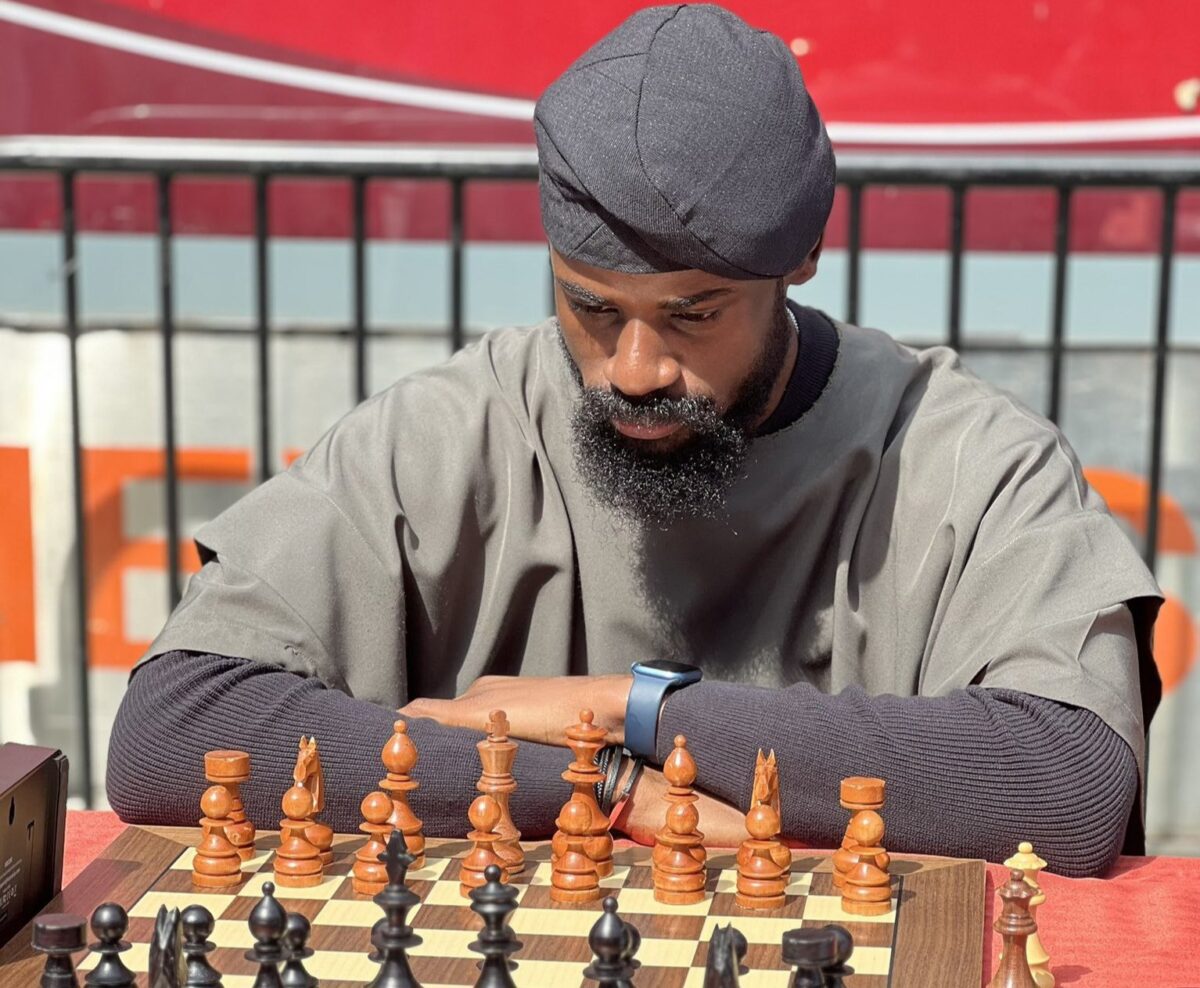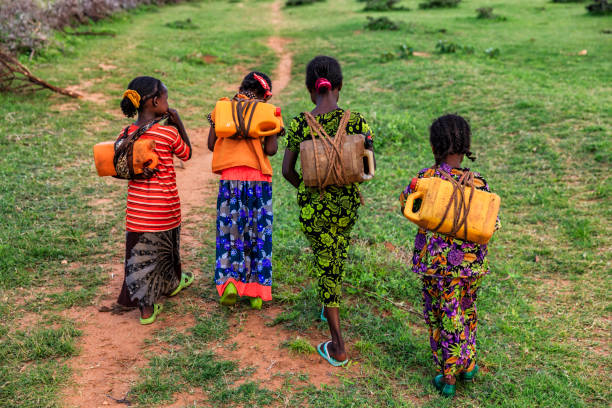It was 11:33 am on a Friday at the Caretaker Community School, Ogbomoso, Oyo State. A time in between the school’s break time of 30 minutes. Students littered the playground as they engaged in various activities. Some of the boys played football on a patchy field in front of the school, while many others hung around watching them play. The girls formed circles, holding conversations and playing games of their own. At the ring of the bell, they will return to their classes to continue learning or not.
Although Caretaker Community School was established as far back as 1980, pupils learning is largely dependent on the season of the year. This is because their classrooms, although wide, lie in a depleted state, which makes learning difficult when it rains. With trees at the back of the junior secondary school block and classrooms with no windows or doors, a rainy afternoon often meant an end to their classes for the day.
“If the rain is really heavy or the wind is strong, the room becomes very uncomfortable to stay in, even the sound in the room makes it very hard to hear the teacher. So sometimes, they may not even come”, a student complained.
Apart from the pitter-patter sounds of the rain on the roof that drown conversations and teachings, heavy gusts of wind also blow rain into the classrooms, splashing pupils and further disrupting classes.
Constant plastering has kept the building together over the years, but it takes no soothsayer to see that the junior secondary school block, housing students from JSS 1 to JSS 3, was in dire need of reconstruction.
With students’ classes often disrupted by rainfall — in a country like Nigeria that experiences an average of seven months of rainfall — one wonders how much education these students are able to get within those walls at the peak of the season.
Mrs. Akinwale (not real name), a teacher and administrator of the school, who spoke to FIJ, avoided commenting on the state of the classroom but shared that although classrooms are often the first sign of a bad education delivery system, other amenities are as important. She explained that, apart from having a falling classroom, the students in the junior school have no access to laboratories and cannot see or practise many of the things they are taught.
“What a person sees with his eyes or does with his hand often sticks more to the memory than theory or what they were just told. The absence of the minimum needs for student education affects them in different ways, and it tells when they do exams, especially external ones.”
READ ALSO: INVESTIGATION: How SUBEB Is Building Imaginary Schools in Kano, Crippling Education
BAD BUILDING, NO TEACHERS– TWO SCHOOLS MERGED
Although in the same compound, I.M.G. Practising School 1 and I.M.G. Practising School 2, Ibadan, used to be two separate schools, each operating with their own teachers, students, and administrators. However, when one of the schools’ buildings became too dilapidated and dangerous for habitation, the schools were merged into one, and students from school 2 moved to school 1. According to the Headmistress of School 1, Mrs. Ariyo R.O., a lack of teachers and inadequate classrooms forced the schools to merge their students and resources.
“I.M.G. used to be schools 1 and 2, each operating separately, with its own students, teachers, and heads. However, when one of the schools became too dangerous for children, the schools merged into one, utilizing buildings in the better school. We also did this because of the unavailability of teachers. The merging helped us to have teachers to cover each class.”
The headmistress noted that although the students received some benefits from the federal and state governments, in form of free lunch, textbooks and notebooks, there was still a need to further invest in education, especially in cases like her school, an Early Childhood Care and Education (ECCE) centre and primary school, where the students are in the basic level and all they have access to is teaching, with no educational engagements.
“We now have more parents taking their kids to private basic schools because of the lack of amenities in public ones. Here, we have no playground, a depleted non-functioning library with no books, and no interactive learning materials except textbooks. Students only come to school to read, eat and go home and the enthusiasm for education is not encouraged,” she explained.
She further stated that I.M.G was able to merge students successfully because of the low population in the current classes.
“In a school where they have up to 20 or 30 students in the class already, merging might not be possible as we have done here, and the depleted school would have no option but to keep students in the dangerous building.”
SCHOOL WITH NO INFRASTRUCTURE: THE PLIGHT OF STUDENTS AT THE BASIC EDUCATION LEVEL
According to the Universal Basic Education Act of 2004, “every government in Nigeria shall provide free, compulsory, and universal basic education for every child of primary and junior secondary school age”. Also, every parent and stakeholder in education in a local government area is expected to ensure and see to it that wards receive this education up to the junior secondary school level.
READ ALSO: SPECIAL REPORT: Inside Ilu Aje, a Ghost Village in Oyo, Where Money Has No Value
This act elaborates on the punishment for contravening and the establishment and membership of the universal basic education commission. It stated the establishment of the Universal Basic Education Commission (UBEC) which will formulate the policy guidelines for the successful operation of the universal basic education program in the federation; prescribe the minimum standards for basic education throughout Nigeria in line with the National Policy on Education and the directive of the National Council on Education and ensure the effective monitoring of the standards; among other duties.
In line with these stated duties, the UBEC, in a paper, listed all of the minimum standards for education in Nigeria. These conditions included a teacher-pupil ratio of 1:25 for Early Childhood Care and Education (ECCE), 1:35 for primary school, and 1:40 for junior secondary school. Additionally, all classrooms were expected to be 7m x 8m (56m) wide, with windows and doors made of metal or aluminum, and a library of 120 m2 filled with toys, books (fiction, and non-fiction story books, and novels), audio tapes, videotapes, CDs, computers, and photocopiers to fit the needs of the three categories (ECCE, primary, and junior secondary). Ceilings were expected to be present in the form of a hardboard ceiling (Brazil) and asbestos ceilings for termite-infested areas. It was also expected that schools have laboratories, workshops, and sick bays.
Although all of these have been listed as the minimum, the opposite is the case in many of Nigeria’s schools. Dilapidated buildings, overcrowded classrooms, lack of teachers, and basic amenities such as electricity, computers, toilets, and water mean that students go to school every day to receive education in whatever capacity the administration and teachers can provide for them — a clear indication of the dire state of education in Nigeria and the plight of millions of students who are in school but not learning.
According to a report by the United Nations Children’s Fund (UNICEF), Nigeria is one of the three countries globally with the highest number of out-of-school children in the world, with an estimated 10.5 million children not in school. The report highlighted the poor quality of education in Nigeria, with only 60% of children completing primary school and less than 50% of them being able to read and write.
“Even though primary education is officially free and compulsory, about 10.5 million of the country’s children aged 5-14 years are not in school. Only 61 percent of 6–11-year-olds regularly attend primary school and only 35.6 percent of children aged 36-59 months receive early childhood education.’’
One of the major reasons for the poor quality of education in Nigeria is the lack of infrastructure in schools. Many schools in Nigeria are in a state of disrepair, with crumbling buildings, leaking roofs, and broken windows. These conditions make it difficult for students to focus on their studies, as they are constantly distracted by the poor environment.
In addition to the poor physical infrastructure, there is also a severe shortage of qualified teachers in Nigeria. According to UBEC, the minimum entry requirement for a teacher is a Nigerian Certificate of Education (NCE) qualification, a mandatory registration with the Teachers Registration Council of Nigeria (TRCN), and professional training. However, in 2022, UBEC decried the dwindling number of teachers across the country.
Executive Secretary Hamid Bobboyi (of UBEC) stated in a report that many government-owned primary schools, especially in the north, have no more than one teacher to boast of, and it is a challenge that should challenge the government at all levels in the country.
READ ALSO: VIDEO: Oyo Schoolteacher Forces Pupils to Sing ‘Vote for PDP’
According to the report, “there is no real shortage of teachers in the country since there are vastly educated Nigerians qualified for the job. The problem is the remuneration of teachers in Nigeria. The lack of a decent welfare package for Nigerian teachers has made the job undesirable. Many take to teaching profession simply for want of anything else to do.”
The shortage of teachers means that classrooms are often overcrowded, with more students per class than the recommended ratio, making it difficult for teachers to give individual attention to students.
Kawthar Omisore, a transformative education advocate and the founder of Kuwaysirreads, who spoke to FIJ, explained that to a great extent, convenience determines concentration. The HundrED ambassador whose work in the education space was recently recognized by the United Nations Educational, Scientific and Cultural Organization (UNESCO), explained that learning space to a great extent impacts learning.
“The effect of the lack of a good well-spaced classroom and the absence of learning materials on the studies of students can be likened to the situation of a girl on her period making use of tissues or towels in place of a sanitary pad. Not a minute goes by without her checking to see if she’s stained already. When the classroom is not conducive and comfortable for students to learn, they constantly tug at each other, movement is restricted, comfort is absent, class is in disarray, and executing learning activities becomes a difficult task. All these together with little to no learning material end up affecting students’ responses in class to their teachers and their performance at the end of the session.”
READ ALSO: ‘Yahoo’ School Proprietor, 13 Students Arrested in Benin
To tackle all of these inadequacies, Kawthar proposed that an effective educational investment plan that takes into consideration and brings on board every stakeholder — government, parents, educators, the students — be made.
“To improve investment in education, there is a need for the government to prioritize the educational rights of children and recognize them as a fundamental human right, justifiable and to be enforced, rather than a socio-economic right. There’s not much progress that can be made when the ground norm, the constitution, doesn’t recognize educational rights as enforceable rights.
“It is the government’s duty to provide quality education with all the required needs, and the duty of the ones whom these children go back to and spend most of their time with, to constantly reinforce the importance of education and what it translates to for them and their kids. NGOs, as well as private bodies, should also work with the government to complement and support it in ways they can to improve the quality of education in the country.”
This report is a part of Youth Hub Africa’s Basic Education Media Fellowship 2022 with support from the Malala Fund and Rise Up.
Subscribe
Be the first to receive special investigative reports and features in your inbox.















